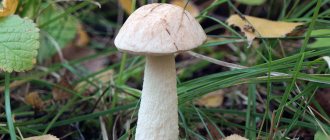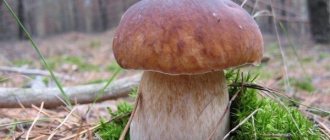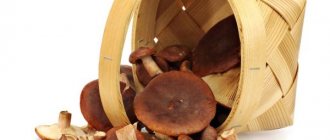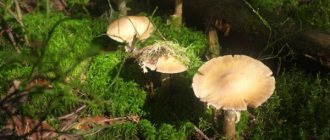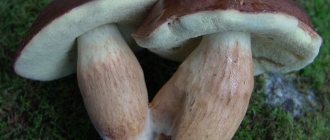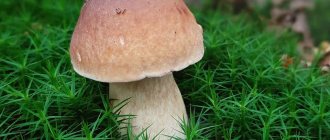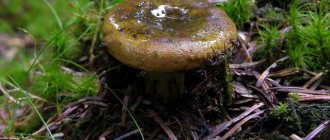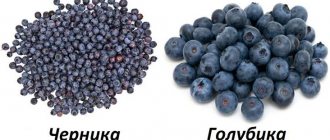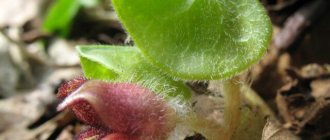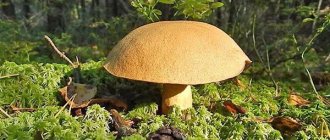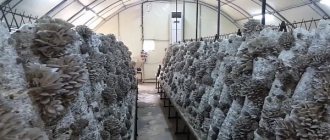Coprinus, or dung beetle from the Champignon family, is a conditionally edible mushroom and has about 25 varieties. Translated from Greek, "kopros" means "manure". Due to its ability to grow in manure, this representative of the fungal world is called the dung mushroom. Such species are scientifically called coprophiles. Most varieties are toxic and are not used in cooking.
However, there are several representatives that are classified as conditionally edible. The most popular varieties are white and gray. With proper heat treatment they acquire a pleasant characteristic taste. The development is very rapid - from the moment of appearance to complete dissolution, 3 hours pass. This species has long been used in writing: after maturation, the dung beetle turns into ink - hence the synonym “inky”.
History of the genus Coprinus
Dung beetle, or Coprinus (lat. Coprinus) is a genus of mushrooms belonging to the champignon or agaric family (Agaricaceae).
The history of this family resembles the history of the old ones. aristocratic families. “My family was once noble, but now dilapidated...” - this can also be said about the genus of dung mushrooms. Or rather, not so dilapidated as noticeably thinned out.
At the end of the twentieth century, it included about five dozen species of mushrooms. But after geneticists intervened, some of the mushrooms were excluded from the genus Coprinus and redistributed into the genera Coprinellus, Coprinopsis and Parasola.
This process has not yet been completed. Therefore, it is difficult to name the exact number of mushrooms included in the genus Coprinus. The Russian and British Wikipedias are still, as they say, confused in their testimony. According to the first version, there are fourteen types of mushrooms, according to the second - eighteen.
Only one thing can be said with confidence: the world of mushrooms is complex, mysterious and not yet fully understood.
This article will focus on dung mushrooms, which are definitely classified in the genus Coprinus.
Description of Coprinus
Their cap shape is conical, bell-shaped or convex. Most often it does not open, but sometimes there are specimens with a flat cap. The top of the mushroom is covered with a coating in the form of flakes or scales.
The stem of the mushroom is hollow, smooth, and has a cylindrical shape.
The cap flesh is not very fleshy. The leg has a fibrous structure.
On the lower part of the cap there are multiple thin white plates that turn black when ripe.
In the photo is the shimmering dung beetle.
Edible species of dung beetles (white dung beetle, gray dung beetle). If you're not sure, don't buy it!
Interesting video
Use in cooking
The dung mushroom is processed immediately after collection, otherwise it will darken and dissolve. Only young mushrooms with unopened caps and snow-white plates are suitable for consumption. If the plate under the cap acquires a yellowish, pink or grayish tint, this specimen should not be used.
Only the caps are used for food; from them you can prepare:
- spice;
- sauces;
- mushroom roast;
- frozen semi-finished product.
Dung beetle spice
The mushrooms, cleaned of debris, washed and dried with a paper towel, are placed in a frying pan and, stirring, simmer over low heat . At first, a lot of water is released from them, and the whole secret of preparing coprinus is to evaporate this water and leave a completely dry mass in the pan. This is done with noble mushrooms using household vegetable dryers, but due to rapid autolysis (self-dissolution) this method is unsuitable for dung beetles.
The dried mass is ground using a blender or coffee grinder and stored in tightly closed glass jars. This seasoning will give dishes the smell of champignons.
When using spices from dung beetles, it is strictly not recommended to mix different types: the mixture can cause food poisoning. In cooking, as a rule, white dung beetle is used - its taste and aroma are the brightest. Gray coprinus powder is used to treat alcoholism.
Roasted coprinus
When preparing dishes from dung beetle pulp, preference is also given to white coprinus. After cleaning the caps from debris, they are quickly washed, carefully dried and, if necessary, cut.
Fry in a frying pan with the addition of vegetable oil; towards the end of cooking, you can add finely chopped onions.
Excess liquid released from coprinuses during frying can be carefully drained and added to the sauce for a side dish: pasta or potatoes.
Frozen mushrooms
Due to autolysis (self-dissolution), dung beetles cannot be frozen raw . Cleaned, washed dung beetles are boiled for 15-20 minutes - only in this form they will not dissolve in the freezer. They can be used as a semi-finished product for making sauces or frying. Frozen coprinuses should be stored for no more than 6 months.
Published on March 16, 2018 by samsonmain. The entry was published in the Conditionally Edible section. Bookmark the permalink.
Features of cooking mushroom lasagna
Directory of mushrooms with photographs: meaning, help for mushroom pickers
Reproduction
A distinctive feature of all coprinuses is their unique method of reproduction. Due to the fact that the lower plates of the fungus, where the spores are contained, are very closely adjacent to each other, coprinus cannot easily disperse them in the wind.
And then it turns on a special mechanism called autolysis. The mushroom produces special enzymes that begin to actively digest the mushroom cap. That is, the mushroom actually eats itself.
As a result of this process, spores are released, and the cap turns into a viscous black liquid that flows from the stem and spreads over the surface of the earth.
An amazing way of self-sacrifice on the part of parents for the sake of continuing their own family!
Interesting article - Grifola curly: listed in the Red Book.
Interesting Facts:
- Fermented coprinuses were used to make sympathetic ink for secret writing and as a means of protecting important government documents and bills of exchange.
- English writer Percy Bysshe Shelley mentioned dung mushrooms in his poem "Mimosa" in 1820.
Their body fell away piece by piece
And the air was infected with its breath,
And soon only trunks were visible,
Damp from the damp, suffocating darkness.
Chemical composition and calorie content of the dung mushroom
100 grams of coprinus mushrooms contain about 22 kcal.
| Squirrels | 46% | 3.9 g |
| Fats | 5% | 0.34 g |
| Carbohydrates | 49% | 3.26 g |
Dung mushrooms also contain fiber, amino acids, B vitamins, macro- and microelements (phosphorus, magnesium, sodium, potassium, calcium, zinc, selenium, manganese).
Important! Please don't eat mushrooms based solely on what you read on the internet!
Description of the Gunin tomato variety, yield, growing features
Tomato Gunin f1 grows in greenhouses under glass and film. The cultivation of a determinate variety of vegetable crops is also carried out in open beds. 100 days after the growing season, you can enjoy the first fruits, which contain a lot of different microelements and vitamins. Juice and pulp of tomatoes:
- Speeds up metabolism.
- Reduces the amount of lipid deposits.
- Increases hemoglobin levels.
Tomatoes function as antioxidants. The components present in the fruits prevent the growth of cancer cells.
Description of culture
Hybrid Gunin f1 is the first determinate variety that was bred in Russia, which is not afraid of many diseases, takes root in different climate conditions, and tolerates sudden changes in air temperature. On bushes of medium height, up to 10 inflorescences are formed, the first of which is formed above the 9th leaf. The fruits are characterized by:
- dense pulp;
- bright red hue;
- smooth surface;
- excellent taste;
- rounded shape.
The first tomato ripens on days 101–111 and weighs 100–120 grams. The harvest begins in July. The last fruits are harvested in September. The leaves and stems of the hybrid are not affected:
- fusarium;
- tobacco mosaic;
- root-knot nematodes.
Sowing and transplanting
Thanks to the characteristics and description of the variety, Gunin tomato began to be planted not only in the southern regions, but also in the middle zone. Summer residents and farmers like the taste of tomatoes and the fact that they ripen earlier than many other hybrids, and at least 5 fruits are set on the inflorescence.
Seeds for seedlings are placed in the soil no deeper than 20 mm. The work is carried out from March 1 to March 20. A square meter of greenhouse can accommodate 3 bushes; in open soil, 2 tomatoes are enough. Seedlings are sent to a permanent bed in May, when frost is no longer expected. Before this procedure, it is fed with sodium humate. Fertilizer accelerates growth and prevents the development of diseases.
3 grams of superphosphate are poured into the holes into which tomato seedlings are moved. If flowers have already appeared, they must be cut off.
In order for the crop to please you with its harvest, you need to get rid of excess stems; after the main one appears, leave another one formed under the first brush. Side shoots must be removed. Thanks to pinching, more light falls on the plant, the fruits are larger and ripen faster.
Watering and fertilizing
The application of fertilizers helps to significantly increase productivity. When a tomato begins to bloom, it needs phosphorus. If there is not enough of this microelement, the leaves become purple; if there is an excess, they turn yellow and the ovary falls off. Crop growth slows down when there is a nitrogen deficiency; when there is too much of it, the bush thickens and there are few tomatoes produced.
Tomatoes respond well to fertilizing with chicken droppings, manure or peat. If possible, it is better to add fertilizer to each bush, which contains potassium sulfate, ammonium nitrate and magnesium in a ratio of 3: 2: 1. Hybrids are watered once a week at the root, but generously.
Tomatoes of the Gunin variety are consumed fresh, used for pickling and to obtain juice. The reviews are only positive.
Speeds up metabolism. Reduces the amount of lipid deposits. Increases hemoglobin levels.
Species of Coprinus
White dung beetle (Coprinus comatus)
Mushroom 5–15 cm high. The cap is white, covered with scales. Because of this, the white dung beetle is also called shaggy. The shape of the cap at a young age is spindle-shaped. Later it opens into the shape of a bell.
The lower plates are thin white, darkening with age. The leg is thin, smooth, hollow, up to 10 cm high.
The white dung beetle is widespread. It grows from spring to autumn in the forest, fields, vegetable gardens, orchards and along roads.
White dung beetle is edible and has good taste. Mushrooms are harvested at a young age and processed quickly. Cut white dung beetles are not stored for long.
Gray dung beetle (Coprinopsis atramentaria)
Mushroom with a gray or grayish-brownish cap. The cap is covered with dark scales. The shape is ovoid when young, then opens into a bell shape with cracked edges. The leg is white, hollow, darkish at the base, 1–2.5 cm in diameter.
The lower plates are wide, white, darkening with age. Found almost everywhere from April to November. Prefers to grow in damp places, gardens, fields, compost heaps and rotting wood debris. Most often it grows in groups.
Belongs to the category of conditionally edible mushrooms. Before use, gray dung beetle must be boiled. The taste of the mushroom is sweetish, there is no smell.
Flickering dung beetle (Coprinellus micaceus)
A mushroom with a bell-shaped or ovoid cap. The cap itself is 2–4 cm in diameter, furrowed, grayish-brown, darker at the apex, covered with small shiny scales. The leg is thin, fibrous, hollow, fragile. The lower plates are thin, adherent, white, darkening with age.
Found almost everywhere. It grows in groups or clumps from May to November on rotting wood, as well as in parks, gardens, pastures, etc.
An inedible mushroom, although it is also not considered poisonous.
Willow dung beetle (Coprinellus truncorum)
A mushroom with an ovoid whitish cap. The grooves on the cap are more pronounced than those of the shimmering dung beetle. The edge of the cap is uneven and split. The leg is long, thin, smooth, white, hollow inside. The lower plates are thin, wide, light, darken and turn brown with age.
The mushroom is widespread. It grows from spring to autumn almost everywhere.
Willow dung beetle is not considered poisonous, but it is not eaten.
Resinous dung beetle (Coprinopsis picacea)
A mushroom with an elongated, egg-shaped, large cap covered with white scales. The cap opens with age, taking on the shape of a bell. The leg is light, thin, hollow, up to 20 cm in height, about 2 cm in diameter, and has a slight coating. The lower plates are light.
Grows singly or in groups on decaying organic materials.
The resinous dung beetle has an unpleasant odor and is not eaten.
Common dung beetle (Parasola plicatilis)
A mushroom with a yellowish closed cap with a diameter of 1–3 cm, which brightens and opens with age. The surface of the cap is folded. The leg is 5–10 cm in height, thin, smooth, light, fragile. The lower plates are greyish, thin, attached.
Distributed almost everywhere.
The folded dung beetle has a very short life span - about a day. The fragile stem cannot withstand the weight of the cap, and the mushroom breaks and dies.
It is not considered poisonous, but is not eaten.
How to recognize white dung beetle - signs and habitats
Probably everyone has seen this mushroom. To do this, you don’t need to go into the forest. Dung beetles grow in large quantities even in cities. It happens that they even come out in flower beds. As their name suggests, they grow in well-fertilized soils. These can be compost heaps, decomposed garbage dumps (of organic origin), pasture areas for cattle and poultry, in the forest near rotten trees, in parks on decomposed leaves. The first mushrooms appear at the beginning of summer and grow until autumn frosts.
The appearance of the mushroom is elongated and elongated with a bell-shaped cap. It can reach fifteen centimeters in height. The leg is straight, hollow inside, and has a thickening at the base. It has a membranous ring at the top. The cap is ovoid, with scales and a bell. The color is white, the top of the cap has an ocher tint. The mushroom does not worm.
How to correctly identify dung beetle - watch the video story. The mushroom picker clearly shows where and how the mushroom grows and how edible it is:
Benefits and harms
Edible species of dung beetles (white dung beetle, gray dung beetle) are recommended for consumption by diabetics due to its hypoglycemic effect. In addition, mushrooms are used in the treatment of prostate diseases. Chinese studies have shown that polysaccharides contained in mushrooms have the ability to strengthen the human immune system. Coprinus is highly valued for its content of B vitamins. It has antioxidant properties, useful in neutralizing free radicals, and also provides the body with important amino acids.
But we should not forget that dung beetles easily absorb harmful substances from the soil, including heavy metals. Therefore, you should pay special attention to the place where you collect mushrooms.
Where to look
On the site, you should look for an unattractive mushroom near a compost pit, trash heap or manure heap. Since coprinus “loves” soil rich in natural fertilizers, it should be collected away from industries, busy highways and large public garbage dumps - such a harvest will be rich in harmful substances and will do more harm than good.
If possible, go for mushrooms away from the city, to meadows and fields where livestock is grazed - the harvest collected there will be both tasty and healthy. Coprinus grows in large families, so harvesting will be quite easy.
How to grow dung mushrooms correctly?
Dung mushrooms can be grown both indoors and in open areas. Due to its unpretentiousness, the mushroom grows well and bears fruit. It is practically not affected by diseases and pests.
If you follow some rules, you can get a good harvest of mushrooms on your plot:
- When grown in open ground conditions, the area should be shaded, moist and cool.
- When growing indoors, be sure to ensure good air circulation.
- To obtain a good harvest, it is necessary to add fertilizers containing calcium to the soil substrate.
- The layer of soil substrate for planting mushrooms must be at least 20 cm.
- To prevent the substrate from drying out, it must be covered with paper or burlap and periodically sprayed with a spray bottle.
- It is necessary to plant mycelium in well-warmed soil.
Where to buy mycelium?
Mushroom mycelium can be bought in specialized stores, garden centers or ordered online. Manufacturers offer liquid, granular and powder forms of mycelium release.
Growing dung beetle at home
To grow white and gray dung beetles, prepare a bed in a shady place and fertilize it well. In the fall, the grown mushrooms are dug up along with the mycelium and planted in a prepared flower bed. The harvest is harvested next year.
Dung beetles are also grown in beds and boxes, like champignons.
Humus, tops, fallen leaves, manure and straw are used as a substrate. It is placed in wooden boxes or bags, and the mycelium is buried to a depth of 4-6 cm. Then it is watered several times, and the top is sprinkled with a layer of earth up to 4 cm, and covered with cardboard or paper. The temperature in the room should not exceed 30 °C.
The first harvest is harvested after 2-3 weeks. The mycelium produces harvests several times throughout the year.
Processing and storage
Proper culinary processing of coprinuses has a number of subtleties:
- Only young mushrooms with unopened caps should be eaten.
- Dung beetles are cooked within 1–2 hours after collection, as they spoil very quickly.
- Before cooking, mushrooms must be thoroughly washed in plenty of water and allowed to drain.
- Dung mushrooms are not suitable for drying and canning.
- Mushrooms can only be stored frozen. They must be fried or boiled before freezing.
- Dung mushrooms should not be consumed in combination with other mushrooms.
- Dung mushrooms should not be consumed in combination with alcohol.
White or Inky Dung Beetle Coprinus Comatus
Dung beetle is an ordinary mushroom with a tasteless name.
The only truly edible mushroom of this genus. It has excellent taste and is highly appreciated by true connoisseurs. Also known as Ink Mushroom.
Appearance
The cap is up to 15 cm high and up to 10 cm in diameter, initially spindle-shaped, then bell-shaped. It has a white or grayish color, which darkens over time, and is covered with very characteristic wavy “shags”. A dark tubercle is often visible in the center of the cap.
The hymenophore is lamellar, the plates are wide, very frequent and free, initially white, then turning pink, darkening, and self-destructing along with the cap. Spore powder is black.
About two days after hatching from the soil, the cap begins to bleed dark liquid, turns black and shrivels until it all turns to ink.
The leg is long, up to 35 cm high and up to 2 cm in diameter, hollow and cylindrical, centrally located. The leg is white, with a silky tint, and a slight thickening is visible at its base. On top of the stem there remains a fragile white film ring, which often falls off as the mushroom grows, and if it does not have time to fall off, it becomes very dark from the “ink” dripping from above.
The pulp is soft and white, with a faint pleasant taste and smell.
Where and when does it grow
White dung beetle is widespread in the northern temperate zone, found wherever loose, well-fertilized soils are present - in fields, gardens, vegetable gardens, in cities near garbage dumps and garbage dumps, on manure heaps and along roads. It can get caught in the most unexpected places. Often found simultaneously in colossal quantities. Fruits from May to late autumn.
Culinary use
Not all collectors are aware of the wonderful taste of this mushroom. Due to its small size, characteristic appearance and habit of growing anywhere, including in the most unappetizing places, many people mistake it for a type of toadstool. However, those who are familiar with the taste of the White Dung beetle appreciate it extremely. According to experts, this mushroom is especially good fried with omelet or sour cream. In France, the Czech Republic and Finland, dung beetle is generally revered as a delicacy.
When eating White Dung beetle, you need to follow some rules:
- Fruiting bodies can be collected only at a very young age, until the hymenophore plates begin to darken - approximately within two days after the mushroom emerges from the ground. There is evidence of the successful consumption of dung beetles even with a fairly darkened cap - but there is no point in experimenting with this again.
- The decomposition process continues in mushrooms that have already been cut, so they must be processed no later than 2 hours after collection. According to available information, the “inking” process continues to occur even in frozen specimens.
- It is recommended to boil dung beetles for 15 – 20 minutes before eating. Those who like to cook this mushroom immediately in its raw form desperately argue with this, arguing that boiling only reduces the taste of the mushroom. Whether this is true or not, and who, in this case, is right, is still unknown.
- It is not recommended to mix dung beetles in the same dish with other mushrooms.
- It is believed that dung beetles accumulate various toxic substances with particular zeal, so they are not recommended to be collected along major highways, industrial enterprises and other sources of environmental problems.
- Evidence of the toxicity of this mushroom when interacting with alcohol has not been confirmed, so dung beetle does not help against drunkenness. However, this should not serve as a reason for abuse.
For special purposes
This species of dung beetles has long had another use. The ink produced by the self-decomposition of the cap was used to compile particularly important government documents. It was believed that inscriptions made with this ink could not be faked, since if you look at the document through a microscope, then fungal spores will be clearly visible in the frozen ink, making up a unique pattern that could be recorded and could not be deliberately repeated.
Dung mushroom for alcoholism
Gray dung beetle and dung beetle can cause serious negative reactions when consumed with alcohol.
Mushrooms contain the substance coprine, which when combined with alcohol can cause dizziness, nausea, fever and abdominal pain.
Pharmaceutical companies drew attention to this feature and began to use coprine (both natural and synthesized) to produce drugs that help in the treatment of alcohol addiction.
For the same purpose, dung mushrooms are used in alternative medicine. It is believed that daily use of small doses of coprinus causes a persistent aversion to alcohol in the patient.
But it is better to consult a doctor!
Useful and healing properties
Dung mushrooms have many beneficial properties:
- Increase appetite.
- Reduces sugar levels and blood pressure.
- Slow down tumor growth.
- Stops minor bleeding.
- Eliminate signs of the inflammatory process.
- Suppresses the growth of bacteria.
- Remove toxic substances.
Gray dung beetle is used to treat alcoholism. The mushroom contains the substance coprine, which prevents the breakdown of the breakdown products of ethyl alcohol, and severe intoxication of the body occurs. This causes an aversion to alcohol.
mushrooms, subject to contraindications and intake standards, will only have a positive effect on human health
Ways to combat dung fungus on the site
Due to its unpretentiousness, the dung mushroom grows almost everywhere. And this creates certain difficulties for garden owners. Spreading black puddles on the lawn and beds are not a particularly pleasant sight.
In order to get rid of mushrooms on the site, it is necessary not to create favorable conditions for their growth.
Do not store rotting wood on the site. If possible, you should avoid mulching your garden with sawdust.
Lawn aeration is also an effective means of controlling dung beetles. To do this, it is worth pricking the lawn with a pitchfork as often as possible.
In areas well lit by the sun, dung mushrooms do not grow.
Traditional medicine recipes
Dung beetle is a nutritious mushroom with excellent taste. It is somewhat reminiscent of champignons, so preparing coprinus quickly will not be difficult.
It is necessary to heat the frying pan thoroughly and put a few tablespoons of butter or vegetable oil on it. Mushrooms should be washed and the caps separated from the stems. Then the caps need to be thrown into the frying pan, salted and simmered over low heat. There is no need to add water, since the dung beetles themselves are very juicy.
You can add a small amount of the medicine to the food or drink of a person suffering from alcohol dependence. He will not even feel any taste and will not guess about the anonymous treatment.
We suggest you read: Panangin after binge drinking - Harm of Smoking
There are a large number of traditional medicine recipes using dung beetle. If coprinus is used as an anti-alcohol drug, you can use the following recipes:
- Powder. For cooking you will need fresh gray or porcini dung mushrooms. They need to be placed in a dry, heated frying pan and fried, stirring constantly. The mushrooms will first produce juice, then it will evaporate and the pulp will become dry. Once the coprinus is well dried, the pan can be removed from the heat. Finely chop the mushrooms to a powder. Store in a jar with a tightly closed lid in a dark and cool place. Add the resulting powder to the patient’s food, 1 tablespoon at a time.
- Infusion. To treat alcoholism, you can only prepare a water infusion. It is prohibited to use alcohol for these purposes. To get the medicine, you need to mix 2 tablespoons of coprinus with 500 ml of hot water. Place on fire and bring to a boil. After this, remove from heat and leave to brew for 8 hours. You need to take this infusion ½ glass 2 times a day.
- Ointment. There is no point in using the ointment to treat alcoholism, but it will help against wounds and boils.
